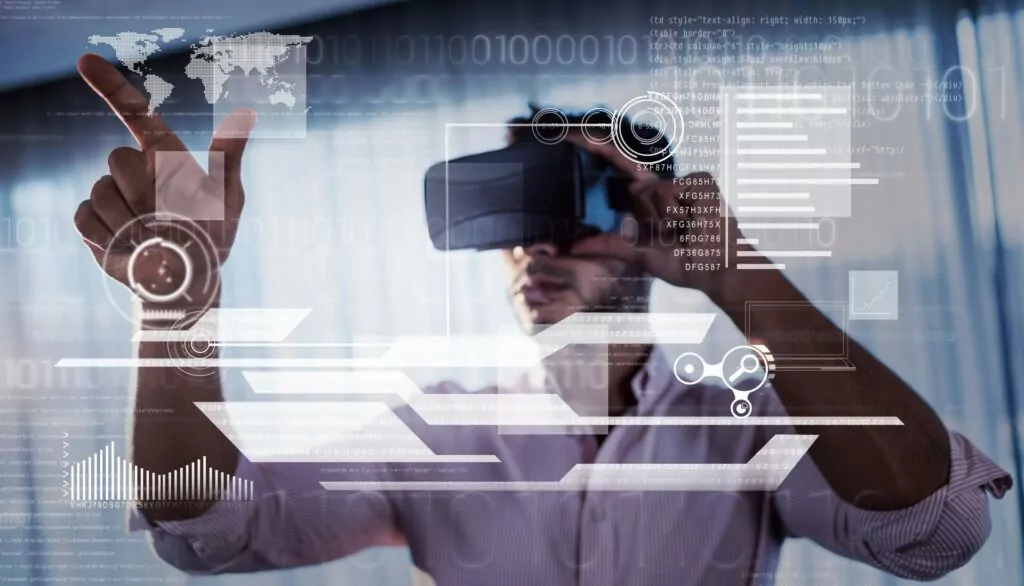Augmented reality (AR) and virtual reality (VR) are revolutionising how companies reach their customers. Such is their impact‚ PwC estimate that AR and VR will boost US GDP by $360 billion before 2030. But the two are often confused:
- Augmented reality (AR) uses devices‚ such as mobiles or smart glasses‚ to enhance the world around you. A notable example is Pokémon Go‚ which takes the real-world view from your mobile’s camera and places images and characters on top. The key with AR is that your vision is still in the real world‚ with AR adding extra information and overlays.
- Virtual reality (VR) uses headsets‚ such as the Oculus Quest‚ to block out the real world. It then displays images‚ videos or games throughout your visual field to create a ‘virtual world’. Unlike AR‚ VR completely immerses you in this virtual world.
In their early stages‚ AR and VR were mainly used in gaming or entertainment. Recent years have seen more serious developments. In particular‚ these technologies have made their impact on travel‚ finance‚ retail and manufacturing.

Why are AR/VR important for travel?
Travel has suffered in recent years due to pandemic restrictions – but that has acted as a catalyst with significant advancements in industry technology. Mobile VR apps‚ such as National Geographic VR and Wander‚ transport users to locations across the globe. And while it might never replace the real thing‚ there is further potential for VR in travel.
Tourists will use virtual tours to plan future trips. Destinations‚ resorts and attractions will use VR to offer a never-before-seen ‘try before you buy’ experience.
The possibilities for AR in travel are even more extraordinary. Apps like World Around Me turn mobile devices into personal tour guides. They also use the device’s camera to label points of interest‚ hotels and services. AR is already making travel much easier‚ safer and more immersive.
In the future‚ AR travel apps will personalise tourism and make suggestions that take trips to the next level. Museums and historical sites will use the power of mobile apps to bring their stories to life through AR.
Why are AR/VR important for finance?
Financial institutions have begun to reap the rewards of AR and VR. Fidelity Labs‚ for example‚ already offers VR financial advisors to help customers with their investments. Other banks have streamlined workflows using VR‚ with Swissquote traders using headsets to visualise trading walls. This immersive information helps them make faster and smarter trading decisions. The future of VR in finance will carry on down this path‚ leading to further rises in accessibility‚ knowledge and security.
Similarly‚ augmented reality in finance will help to increase user awareness and knowledge of their assets. This will encourage a much more personal connection to financial institutions. Mobile apps‚ such as Wombat‚ have already broken traditional barriers within financial services‚ educating users throughout their journey.
AR will add to the possibilities. Users will visualise financial information and learn about money through data and gamification. They can even find banks and ATMs on the go. In short‚ AR and VR will help users manage their money – but how will they spend it?
Why are AR/VR important for retail?
Much like travel‚ retail went through a massive period of adjustment during the pandemic. Advancements such as instant click-and-collect and rapid home delivery reduced friction for shoppers.
Today‚ stores are back open‚ using AR and VR to offer a seamless‚ omnichannel‚ ‘hybrid’ experience. Shoppers can enjoy all the benefits of shopping in person‚ combined with the convenience of browsing online. For example‚ Walmart has already developed technology that lets users try on clothes in immersive VR changing rooms.
Likewise‚ AR in retail enhances the shopping experience. Companies like IWC have already launched apps that let users try on expensive jewellery at home. Many clothes retailers have done the same.
In-store‚ hologram displays save space in shops‚ while AR apps suggest relevant products and accessories based on what clothes shoppers are already trying on. This enhances the customer experience‚ encouraging added spend and loyalty.
AR and VR have proven instrumental in bolstering the customer experience. But beyond the benefits of higher revenue‚ they’ve also helped to improve processes in other industries. We’re seeing this in real-time within the manufacturing sector.

Why are AR/VR important for manufacturing?
Last but not least‚ AR and VR have driven seismic change in supply chain. This is particularly pertinent in a post-pandemic world. Manufacturers are now expected to produce outstanding products even faster.
Many industries‚ such as automotive‚ are already using VR for prototyping and design. This lets creative teams test a more comprehensive range of possibilities faster than ever. Manufacturing will also use VR to train new employees – freeing up resources and helping companies to train more thoroughly and safely.
There’s further exciting news with AR in manufacturing. Mobile apps and smart glasses display essential information for engineers and operators‚ helping them get the job done safely. AR will also help with the final stages of manufacturing‚ such as delivery.
Staff will be able to access product locations and packing details using AR on mobile devices‚ streamlining the manufacturing process from start to finish. VR and AR offer exciting innovations at every stage of production.
We’ve only just begun to see the possibilities of AR and VR across various industries. As customers’ needs change‚ these technologies will take centre stage across a range of sectors. By embracing this change‚ companies can watch efficiency‚ reach and customer satisfaction soar.





